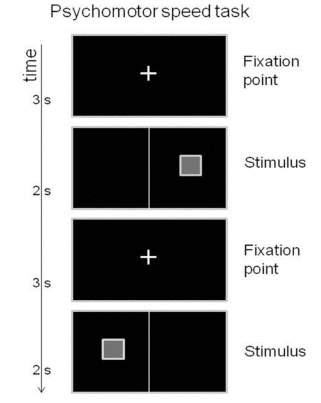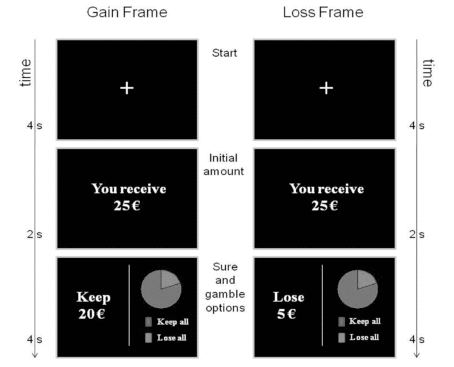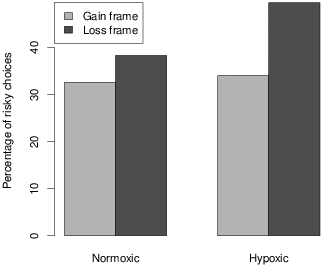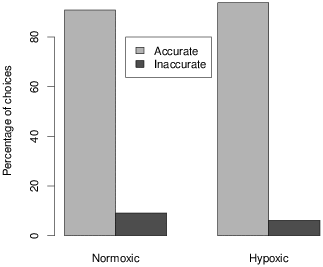Judgment and Decision Making, vol. 7, no. 4, July 2012, pp.
Decision making under hypoxia: Oxygen depletion increases risk seeking for losses but not for gains
Stefania Pighin*
Nicolao Bonini#
Lucia Savadori#
Constantinos Hadjichristidis#
Tommaso Antonetti%
Federico Schena%
|
We report a preliminary study that compared decisions made in an
oxygen depleted environment with those made in a normoxic
environment. Participants were presented with a series of choices that
involved either losses or gains. For each choice they were forced to
choose between a sure thing and a gamble of the same expected
value. For choices involving losses, participants were more risk
seeking in the oxygen depleted environment; for those involving gains,
no difference was found.
Keywords: oxygen depletion, hypoxia, risk aversion.
1 Introduction
Hypoxia is the result of an inadequate oxygen supply to the cells and
tissues of the body. Low aerial oxygen concentration is first detected
by sensory receptors in the carotid body and then relayed to the
hypothalamus (Kalia & Welles, 1980; Swanson & Sawchenko, 1983). The
body responds to the decrease in the oxygen arterial saturation by
increasing heart rate, blood pressure, ventilation, and the production
of stress hormones (Buchheit, Richard, Doutreleau, Lonsdorfer-Wolf,
Brandenberger, & Simon, 2004; Fishman, Fritts, & Cournand, 1960;
Richalet, Letournel, & Souberbielle, 2010). Such alterations are
driven by the sympathetic nervous system and could reach awareness if
oxygen depletion is sufficiently high. However, mild oxygen depletion
is not easily detected by higher-order brain structures (Herman &
Cullian, 1997).
Research has investigated the effects of hypoxia on human cognitive
functions (Virués-Ortega, Buela-Casal, Garrido, & Alcázar,
2004). Most studies focused on basic functions, such as visual
perception, memory, attention, and language (Lieberman, Protopapas &
Kanki, 1995; Lieberman, Protopapas, Kanki, Reed & Youngs, 1994;
Nelson, Dunlosky, White, Steinberg, Townes & Anderson, 1990; Townes,
Hornbein, Schoene, Sarnquist & Grant, 1984). The data show that a
15% reduction in the arterial blood oxygen saturation diminishes
individuals’ concentration capacity and muscular coordination, which
impairs language production and visual perception (Ward, 1975). A 25%
reduction in the arterial blood oxygen saturation diminishes memory
performance and induces emotional lability and major motor
impairments.
With the present research we aim to investigate the effect of hypoxia
on judgment and decision making. We believe that such research is
worth pursuing for two reasons. First, people frequently experience
mild levels of hypoxia, such as during prolonged physical exercise,
underwater diving, high altitude recreational activities (e.g.,
mountaineering, paragliding, parachuting) or a flight when a defect
occurs to the cabin pressurization system. Second, bad judgments and
decisions during these activities can be fatal.
Although there is no direct research on the impact of hypoxia on
judgment and decision making, there is research concerning the impact
of its effect (stress). Current views on cognitive system architecture
nested within dual-process approaches (Evans, 2003; Kahneman &
Frederick, 2003; Reyna, 2004) suggest that stressful conditions affect
decision-making by broadening the prevalence of intuitive, automatic
processes over analytic, deliberative ones. In stressful situations
individuals might rely on simple rules of thumb or heuristics, rather
than on analytic processes that aim to maximize subjective
utility. Although heuristics in certain contexts are efficient guides
for routine but complex tasks (Gigerenzer & Todd, 1999; Kahneman, Slovic &
Tversky, 1982), in others they can lead to systematic biases. For
example, recent research (Porcelli & Delgado, 2009) has shown that
acute stress induced by keeping ones hand in freezing water modulates
gamble decisions, partially exacerbating a bias known as the
reflection effect: people’s tendency to avoid risk to secure
a certain gain and to seek risk to avoid a certain loss (Kahneman &
Frederick, 2007; Kahneman & Tversky, 1979).
With the present research we investigated whether oxygen depletion
also leads to an exacerbation of the reflection effect. In a
laboratory setting, we compared decisions made in a mildly
oxygen-depleted environment with those made in a normoxic
environment. In contrast to previous studies where participants were
aware of the stressor used (e.g., time pressure; cold water; social
pressure), participants in the present study were not aware of the
mild oxygen depletion. We investigated the reflection effect using a
task adapted by De Martino, Kumaran, Seymour, and Dolan (2006) where
participants had to make a series of forced binary choices between a
sure thing and a gamble of the same expected value, either in the
domain of gains or losses.
2 Method
| Table 1: The subjective feelings questionnaire. The 11 items were
partially adapted from the HADS scale (Hospital Anxiety and
Depression Scale). They involved general anxiety items (Q1 to Q7),
and specific anxiety items related to the hypoxic room (Q8 to
Q11). For each item, participants could respond by selecting one of
four options: 1= Not at all; 2= A little bit; 3= Yes, but not very
much; 4= Yes, absolutely. |
Number | Item |
Q1. | I feel tense, restless. |
Q2. | I sense fear, as something negative is going to happen. |
Q3. | Worrying thoughts keep buzzing around in my head. |
Q4. | I can sit here and feel relaxed. |
Q5. | I have a strange feeling, like butterflies in my stomach. |
Q6. | I feel restless, as I should stay in movement. |
Q7. | I feel panic. |
Q8. | I have shortness of breath. |
Q9. | I feel dizzy. |
Q10. | I feel euphoric. |
Q11. | I have a feeling of heaviness. |
A sample of 30 right-handed university students [14 males (mean age
23.3 years ± 4); 16 females (mean age 20.5 years ±
1.9)] volunteered to participate in the study. They were informed that
the aim of the study was to investigate the effects of high altitude
on decision making. All participants took part in three research sessions,
which were separated by a 7-day interval: a familiarization session in
normoxic condition (oxygen concentration of 20.9%); a control session
in normoxic condition (identical to the familiarization session); and
an experimental session in hypoxic condition (oxygen concentration of
14.1%). These parameters were chosen because they simulate
respectively an altitude of 0 meters above sea level (normoxic) and an
altitude of 3,000 meters above sea level (hypoxic).1 The familiarization session was always first
and aimed to familiarize participants with the laboratory (i.e., the
hypoxic room2) and the computer-based decision tasks. The
order of the normoxic and hypoxic sessions was counterbalanced: 15
participants received the normoxic session followed by the hypoxic
session, while the rest received the reverse order. To eliminate
potential demand characteristics, participants and experimenter were
blind as to the order of the sessions.
The procedure was identical in all three sessions. Participants
entered the room one at a time, the experimenter applied to them
technical equipment that measured some physiological parameters, and
then asked them to watch a neutral video on mountain settings for 20
minutes, to allow enough time for the physiological alterations to
take place. Subsequently, participants had to perform a psychomotor
speed task followed by the target risk-taking task. These tasks will
be described in detail below. To assess whether participants were
aware of the oxygen manipulation, at the end of each session we asked
them to state which condition they believed it was,3 and to fill a questionnaire concerning
self-reported feelings (Table 1).
| Figure 1: Computer-based psychomotor speed task. Participants were
presented with a sequence of 32 trials, where the target stimulus (a
green square) was presented either on the right or
left. Participants were instructed to respond as fast as they could
by pressing the left button on a keyboard when the stimulus appeared
on the left, and the right button when the stimulus appeared on the
right. Both response accuracy and response times were registered. |

We measured two physiological parameters during each session: heart
rate and oxygen arterial saturation (SaO2). Heart rate was recorded in
5 sec intervals (Polar Electro Oy, Kempele, Finland). SaO2 was
measured by a portable pulsoximeter (Intermed SAT-500). Measurements
were taken on the index finger of the right hand. SaO2 levels were
recorded at three points: end of the video (about 25 min after the
entrance in the hypoxic room); beginning of the risk-taking task
(about 35 min after the entrance in the hypoxic room); and end of the
risk-taking task (about 70 min after the entrance in the hypoxic
room). We expected higher heart rate and lower SaO2 in the hypoxic
condition. Participants were asked to perform a psychomotor speed task
after the video task (see Figure 1). Based on previous studies we
hypothesized that hypoxia would slow down psychomotor performance
(Dykiert, Hall, van Gemeren, Benson, Der, Starr, & Deary, 2010;
Kobrick, 1975).
| Figure 2: The computer-based risk-taking task adapted from De Martino, Kumaran, Seymour, & Dolan (2006). |

In each session, the risk-taking task was a computer-based task
adapted from De Martino, Kumaran, Seymour, and Dolan (2006), in which
participants had to respond to a sequence of choices (Figure 2). In
each trial, participants had to choose between either a sure thing or
a gamble option. The protocol was programmed in E-Prime (Psychology
Software Tools, Pittsburgh). The task began with an instruction phase
followed by sixteen practice trials. The task was divided in two
blocks of 48 trials (16 loss frame, 16 gain frame, and 16 catch
trials), ordered randomly. Each trial began with a starting amount of
money (e.g., “You receive 25 €”),displayed for 2
sec. Following De Martino et al. (2006), the starting amounts of
money were: 25€, 50€, 75€, or
100€. Then, the choice between a sure and a gamble option
was presented, for 4 sec, either in a gain or loss frame. The sure
thing was presented as the amount of money a participant could retain
(in the gain frame) or lose (in the loss frame) for sure from the
initial amount of money indicated in that trial. The gamble option was
presented by means of a pie chart depicting the probability of winning
(in green) or losing (in red) the whole initial amount of money. The
expected values of each pair of options were equal. Four probabilities
of winning (or losing) were used: 20%, 40%, 60%, or 80%. All
variables were fully balanced across frame conditions. The two blocks
were composed of the same trials, but presented in a different order,
and with a reverse presentation order of the two options (left vs.
right side of the screen). Sixteen catch trials in each block were
included to check whether participants actively engaged in the
task. In catch trials the outcomes related to the two options were not
equivalent (i.e., one option was dominant as in De Martino et al.,
2006). Participants were instructed to be fast and accurate. They were
also told that they would not receive any feedback concerning the
outcome of their decisions. Instead, at the end of the three sessions
one of their decisions would be extracted randomly and be honoured
with real money (between 0–100 €).
3 Results
3.1 Manipulation checks
As expected, the oxygen depletion manipulation altered physiological
responses. Participants in the hypoxic vs. normoxic session showed
higher heart rate [84 vs. 78.1; t(29)=3.92, p<.001, mean
increase of 8.09%], lower oxygen arterial saturation [90.5 vs. 98.5;
t(29)=15.13, p<.001, mean decrease of 8.08%], and higher
psychomotor response times [588.6 vs. 545.7; t(1,29)=2.6, p=.013,
mean increase of 8.85%]. Participants seemed unaware of the oxygen
manipulation: their responses as to which session they thought they
were did not deviate significantly from chance [McNemar
p=.60]. Moreover, self-reported feelings did not differ between the
hypoxic and normoxic sessions [t(29)=1.27, p=.214].
| Figure 3: Percentage of gamble choices by session (normoxic vs.
hypoxic) and frame (gain vs. loss). In both sessions, participants
were more risk seeking for losses versus gains. Participants were
generally risk averse but their risk seeking significantly increased
only in the loss frame of the hypoxic session. |

3.2 Risk-taking task
| Figure 4: Percentage of accurate (and inaccurate) choices to catch
trials by session (normoxic vs. hypoxic). |

Turning to the target task (see Figure 3), the effect of hypoxia on
choice was examined by a 2 (oxygen level: normoxia vs. hypoxia) x 2
(decision frame: gain vs. loss) repeated measure analysis of variance
(ANOVA), conducted on gamble choices.4 Results revealed a
significant main effect of decision frame, F(1,28)=33.75,
p<.001, ηp2=.55. Participants showed
greater risk seeking in the loss frame than in the gain frame, both in
the normoxic session [12.3 vs. 10.4, t(29)=2.95, p=.006] and hypoxic
session [15.3 vs. 10.9, t(21)=5, p<.001]. Thus, independent
of session and as predicted by the reflection effect, participants
were more risk seeking in the loss frame (44%) than in the gain frame
(33%). Results also revealed a significant main effect of oxygen
level, F(1,28)=4.8, p=-037, ηp2=.15, showing a
greater risk seeking in the hypoxic condition than in the normoxic one
[mean = 26.7 vs. 22.7, t(29)=2.22, p=.034], but this main effect was
qualified by a significant interaction between the two factors,
F(1,28)=7.77, p=.009, ηp2=.22. Although
participants in the hypoxic versus normoxic sessions were equally risk
averse for gambles in the gain frame [t(29)=.55, p=.58], they were
significantly more risk seeking for gambles in the loss frame
[t(29)=2.83, p=.008]. This interaction does not seem to be mediated by
attention. If this were the case, one should also find differences
between the hypoxic and normoxic sessions for experimental trials
involving gains and for catch trials, but no such
differences were found (Figure 4).
4 Discussion
We reported a preliminary study that examined how a mild decrease in
oxygen level (from 20.9% to 14.1%) influences the reflection
effect. We found that under a mild decrease in oxygen level the
reflection effect was exacerbated. The locus of the effect of hypoxia
on the reflection effect was in the domain of losses. The mild
decrease in oxygen level increased risk seeking in the domain of
losses, but had no effect in the domain of gains.
This preliminary finding can contribute to the scientific debate among
neuroeconomists about whether the difference in risk attitudes for
decisions involving gains versus losses is a by-product of a single
brain system or the interaction of multiple systems. Several authors,
on the basis of neuroimaging data, suggest that decisions regarding
losses and gains are adequately explained by a single system that
treats them asymmetrically (Tom, Fox, Trepel, & Poldrack,
2007). Other authors sustain that the difference between gains and
losses supports the existence of separate systems, and that losses
evoke an over-learned fear response that overrides deliberative
assessments (De Martino, Camerer, & Adolphs, 2010). The interactive
effect of hypoxia obtained in the present research suggests that
losses and gains are treated by separated brain systems.
The present study is the first attempt to investigate experimentally
the effect of hypoxia on decision-making, adding experimental support
to the idea that heuristic judgment underpins decisions in high risk
situations, such as ones that have to be made in adverse environmental
conditions (McCammon, 2002). The present research is preliminary and
thus needs to be consolidated by future research. Future research
could concentrate on at least three issues. First it needs to
replicate the different effect of hypoxia on decisions involving gains
versus decisions involving losses. Second it needs to empirically
investigate the effect of hypoxia on loss aversion. Third it needs to
examine the relation between behavioral risk-taking and hypoxia (e.g.,
using behavioral measures and computer simulations).
References
Buchheit, M., Richard, R., Doutreleau, S., Lonsdorfer-Wolf, E.,
Brandenberger, G., & Simon, C. (2004). Effect of avute hypoxia on
heart rate variability at rest and during
exercise. International Journal of Sports Medicine, 25,
264–269.
De Martino, B., Camerer, C. F., & Adolphs, R. (2010). Amygdala damage
eliminates monetary loss aversion. Proceedings of the
National Academy of Sciences, 107, 3788–3792.
De Martino, B., Kumaran, D., Seymour, B., & Dolan,
R. J. (2006). Frames, biases, and rational decision-making in the
human brain. Science, 313, 684–687.
Dykiert, D., Hall, D., van Gemeren, N., Benson, R., Der, G., Starr,
J. M., & Deary, I. J. (2010). The effects of high altitude on choice
reaction time mean and intra-individual variability: Results of the
Edinburgh altitude research expedition of
2008. Neuropsychology, 24, 391–401.
Evans, J. S. B. T. (2003). In two minds: Dual-process accounts of
reasoning. Trends in Cognitive Sciences, 7,
454–459.
Fishman, A. P., Fritts, H. W., & Cournand, A. (1960). Effects of
acute hypoxia and exercise on the pulmonary
circulation. Circulation, 22, 204–215.
Gigerenzer, G., & Todd, P. M. (1999). Simple heuristics that
make us smart (pp. 3–34). New York: Oxford University Press.
Herman, J. P., & Cullinan, W. E. (1997). Neurocircuitry of stress:
Central control of the hypothalamo-pituitary-adrenocortical
axis. Trends in Neurosciences, 20, 78–84.
Kahneman, D., & Frederick, S. (2003). Representativeness revisited:
Attribute substitution in intuitive judgment. In T. D. Gilovich,
D. Griffin, D. Kahneman (Eds.) Heuristics and biases: The
psychology of intuitive judgment (pp. 49–81) New York: Cambridge
University Press.
Kahneman, D., & Frederick, S. (2007). Frames and brains: elicitation
and control of response tendencies. Trends in Cognitive
Sciences, 11, 45–46.
Kahneman, D., Slovic, P., & Tversky, A. (1982). Judgment
under uncertainty: Heuristics and biases. New York: Cambridge
University Press.
Kahneman, D., & Tversky, A. (1979). Prospect theory: An analysis of
decisions under risk. Econometrica, 47, 263–291.
Kalia, M., & Welles, R. V. (1980). Brain stem projections of the
aortic nerve in the cat: A study using tetramethyl benzidine as the
substrate for horseradish peroxidase. Brain Research, 188,
23–32.
Kobrick, J. L. (1975). Effects of hypoxia on peripheral visual
response to dim stimuli. Perceptual Motor Skills,
41, 467–474.
Lieberman, P., Protopapas, A., & Kanki, B. G. (1995). Speech
production and cognitive deficits on Mt. Everest. Aviation,
Space, and Environmental Medicine, 66, 857–864.
Lieberman, P., Protopapas, A., Reed, E., Youngs, W., & Kanki,
B. G. (1994). Cognitive defects at altitude. Nature,
372, 325.
McCammon, I. (2002). Evidence of heuristics traps in recreational
avalanche accidents. Proceedings of the International Snow Science
Workshop, Penticton, British Columbia, Sept. 30. — Oct. 4.
Nelson, T. O., Dunlosky, J., White, D. M., Steinberg, J., Townes,
B. D., & Anderson, D. (1990). Cognition and metacognition at extreme
altitudes on Mount Everest. Journal of Experimental
Psychology: General, 119, 367-74.
Porcelli, A. J., & Delgado, M. R. (2009). Acute stress modulates risk
taking in financial decision making. Psychological Science,
20, 278–283.
Reyna, V. (2004). How people make decisions that involve risk: A dual
process approach. Psychological Science, 13, 60–66.
Richalet, J. P., Letournel, M., & Souberbielle, J. C. (2010). Effects
of high-altitude hypozia on the hormonal response to hypothalamic
factors. American Journal of Physiology: Regulatory,
Integrative and Comparative Physiology, 299, 1685–1692.
Swanson, L. W., & Sawchenko, P. E. (1983) Hypothalamic integration:
Organization of the paraventricular and supraoptic
nuclei. Annual Review of Neuroscience, 6, 269–324.
Tom, S. M., Fox, C. R., Trepel, C., & Poldrack, R. A. (2007). The
neural basis of loss aversion in decision-making under
risk. Science, 315, 515–18.
Townes, B., Hornbein, T., Schoene, R., Sarnquist, F., & Grant,
I. (1984). Human cerebral function at extreme altitude. In J.B. West
& S. Lahiri (Eds.), High altitude and man (pp.
31–36). Bethesda, DC: American Physiological Society.
Virués-Ortega, J., Buela-Casal, G., Garrido, E., & Alcázar,
B. (2004). Neuropsychological functioning associated with
high-altitude exposure. Neuropsychology Review, 14,
197–224.
Ward, M. (1975). Mountain medicine. A clinical study of cold
and high altitude. London: Crosby, Lockwood, Staples.
This document was translated from LATEX by
HEVEA.



